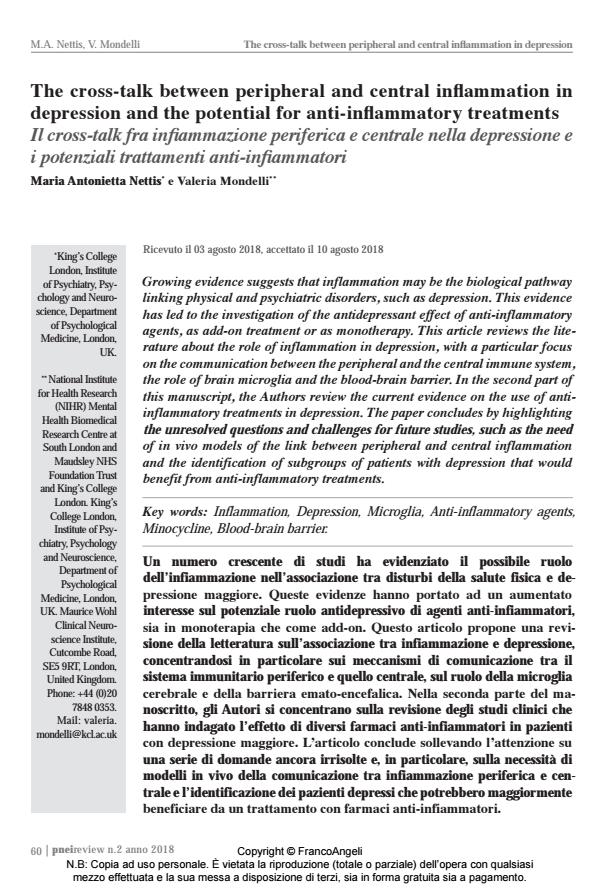The cross-talk between peripheral and central infl ammation in depression and the potential for anti-infl ammatory treatments
Titolo Rivista PNEI REVIEW
Autori/Curatori Maria Antonietta Nettis, Valeria Mondelli
Anno di pubblicazione 2018 Fascicolo 2018/2
Lingua Inglese Numero pagine 12 P. 60-71 Dimensione file 1113 KB
DOI 10.3280/PNEI2018-002005
Il DOI è il codice a barre della proprietà intellettuale: per saperne di più
clicca qui
Qui sotto puoi vedere in anteprima la prima pagina di questo articolo.
Se questo articolo ti interessa, lo puoi acquistare (e scaricare in formato pdf) seguendo le facili indicazioni per acquistare il download credit. Acquista Download Credits per scaricare questo Articolo in formato PDF

FrancoAngeli è membro della Publishers International Linking Association, Inc (PILA)associazione indipendente e non profit per facilitare (attraverso i servizi tecnologici implementati da CrossRef.org) l’accesso degli studiosi ai contenuti digitali nelle pubblicazioni professionali e scientifiche
Growing evidence suggests that inflammation may be the biological pathway linking physical and psychiatric disorders, such as depression. This evidence has led to the investigation of the antidepressant effect of anti-inflammatory agents, as add-on treatment or as monotherapy. This article reviews the literature about the role of inflammation in depression, with a particular focus on the communication between the peripheral and the central immune system, the role of brain microglia and the blood-brain barrier. In the second part of this manuscript, the Authors review the current evidence on the use of antiinflammatory treatments in depression. The paper concludes by highlighting the unresolved questions and challenges for future studies, such as the need of in vivo models of the link between peripheral and central inflammation and the identification of subgroups of patients with depression that would benefit from anti-inflammatory treatments.
Un numero crescente di studi ha evidenziato il possibile ruolo dell’infiammazione nell’associazione tra disturbi della salute fisica e depressione maggiore. Queste evidenze hanno portato ad un aumentato interesse sul potenziale ruolo antidepressivo di agenti anti-infiammatori, sia in monoterapia che come add-on. Questo articolo propone una revisione della letteratura sull’associazione tra infiammazione e depressione, concentrandosi in particolare sui meccanismi di comunicazione tra il sistema immunitario periferico e quello centrale, sul ruolo della microglia cerebrale e della barriera emato-encefalica. Nella seconda parte del manoscritto, gli Autori si concentrano sulla revisione degli studi clinici che hanno indagato l’effetto di diversi farmaci anti-infiammatori in pazienti con depressione maggiore. L’articolo conclude sollevando l’attenzione su una serie di domande ancora irrisolte e, in particolare, sulla necessità di modelli in vivo della comunicazione tra infiammazione periferica e centrale e l’identificazione dei pazienti depressi che potrebbero maggiormente beneficiare da un trattamento con farmaci anti-infiammatori.
Parole chiave:Infiammazione, Depressione, Microglia, Anti-infiammatori, Minociclina, Barriera emato-encefalica.
Maria Antonietta Nettis, Valeria Mondelli, The cross-talk between peripheral and central infl ammation in depression and the potential for anti-infl ammatory treatments in "PNEI REVIEW" 2/2018, pp 60-71, DOI: 10.3280/PNEI2018-002005